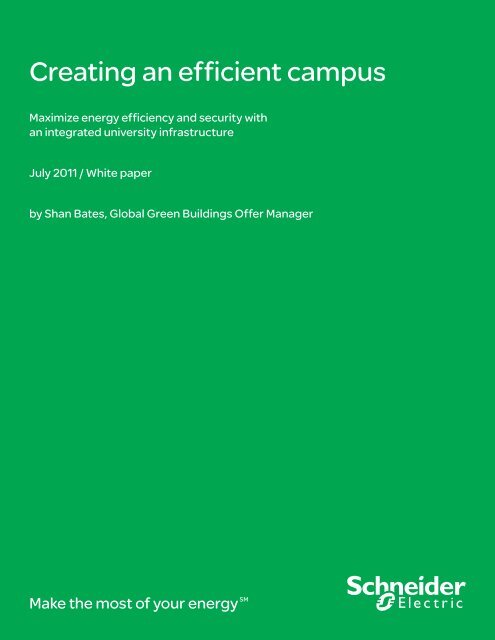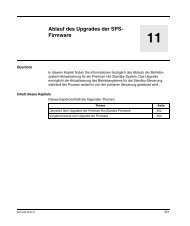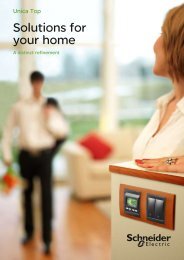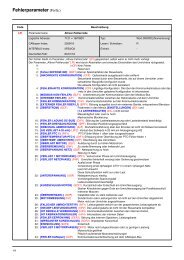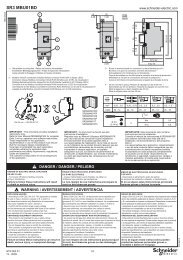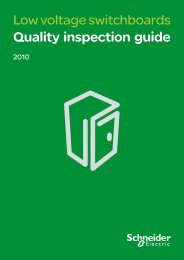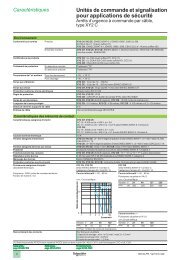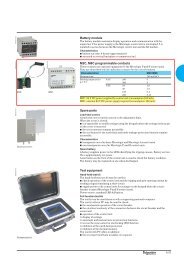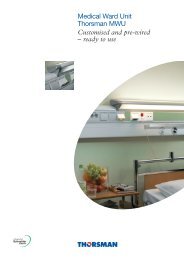Creating an efficient campus (pdf, 1,8 Mo - Schneider Electric
Creating an efficient campus (pdf, 1,8 Mo - Schneider Electric
Creating an efficient campus (pdf, 1,8 Mo - Schneider Electric
Create successful ePaper yourself
Turn your PDF publications into a flip-book with our unique Google optimized e-Paper software.
<strong>Creating</strong> <strong>an</strong> <strong>efficient</strong> <strong>campus</strong><br />
Maximize energy efficiency <strong>an</strong>d security with<br />
<strong>an</strong> integrated university infrastructure<br />
July 2011 / White paper<br />
by Sh<strong>an</strong> Bates, Global Green Buildings Offer M<strong>an</strong>ager<br />
Make the most of your energy SM
Summary<br />
Executive summary ..............................................................................................3<br />
Introduction ..........................................................................................................3<br />
Budget crisis facing the world’s universities .........................................................4<br />
The impact of energy costs on universities ..........................................................5<br />
Security concerns on <strong>campus</strong> .............................................................................7<br />
Designing <strong>an</strong> integrated infrastructure to maximize security<br />
<strong>an</strong>d energy efficiency on <strong>campus</strong> ........................................................................10<br />
Sustaining perform<strong>an</strong>ce over time: building portfolio life cycle strategies ............13<br />
Conclusion ...........................................................................................................15
Executive summary<br />
University <strong>campus</strong>es are complex, dynamic environments that serve a<br />
diverse array of needs <strong>an</strong>d thous<strong>an</strong>ds of people. The challenges faced by<br />
university leaders are daunting: reduced endowments, shrinking budgets,<br />
rising energy costs, aging systems <strong>an</strong>d equipment, increased enrollment,<br />
rising crime on <strong>campus</strong>, <strong>an</strong>d the pressure to demonstrate a commitment to<br />
sustainability. These pressures are motivating institutions to reevaluate their<br />
energy dem<strong>an</strong>ds <strong>an</strong>d related conservation programs, as well as reconsider<br />
their existing security strategies. Surprisingly, these disparate challenges<br />
c<strong>an</strong> be met with <strong>an</strong> eleg<strong>an</strong>t solution that harnesses the power of integrated<br />
technology <strong>an</strong>d ongoing energy efficiency services. The result is <strong>an</strong> <strong>efficient</strong><br />
<strong>campus</strong> that becomes <strong>an</strong> optimal learning environment; saves money; <strong>an</strong>d<br />
protects people, property, <strong>an</strong>d our pl<strong>an</strong>et.<br />
Introduction<br />
Today’s universities face several challenges: decreasing budgets due to the<br />
weak global economy, international competition to attract the best faculty <strong>an</strong>d<br />
students, increased security dem<strong>an</strong>ds on growing <strong>campus</strong>es, <strong>an</strong>d meeting<br />
increasing societal pressures for sustainability. Higher education leaders are<br />
tasked with addressing these issues while simult<strong>an</strong>eously keeping to their<br />
core org<strong>an</strong>isational goals <strong>an</strong>d strategies of delivering the best education,<br />
research, <strong>an</strong>d development outputs.<br />
In the midst of everything taking place across the world’s universities—from<br />
budget sc<strong>an</strong>dals to students hurting other students—university leaders c<strong>an</strong><br />
leverage energy efficiency services <strong>an</strong>d powerful integrated technology<br />
solutions to contain costs, integrate efficiency throughout the entire <strong>campus</strong>,<br />
<strong>an</strong>d provide protection for people <strong>an</strong>d assets.<br />
This white paper describes solutions for higher education executives <strong>an</strong>d<br />
highlights strategies to maximize stretched budgets <strong>an</strong>d meet sustainability<br />
goals while creating <strong>an</strong> optimal learning environment for their students.<br />
<strong>Creating</strong> <strong>an</strong> <strong>efficient</strong> <strong>campus</strong>: maximize energy efficiency <strong>an</strong>d security with <strong>an</strong> integrated university infrastructure<br />
White paper on creating <strong>an</strong> <strong>efficient</strong> <strong>campus</strong> | 3
Budget crisis facing the<br />
world’s universities<br />
Due to the current economic climate, educational<br />
entities are facing difficult budgetary decisions.<br />
Some startling budget issues faced by universities<br />
around the world include:<br />
• The projected cumulative budget deficit in the<br />
US, for all 50 states <strong>an</strong>d Washington D.C., in the<br />
1, 2<br />
year 2011 alone is $142 billion.<br />
• 34 states have already been forced to cut<br />
spending at their colleges <strong>an</strong>d universities,<br />
resulting in furloughs, layoffs, <strong>an</strong>d<br />
increased tuition. 3<br />
• 97% of endowments were affected or<br />
signific<strong>an</strong>tly affected by the economic downturn. 4<br />
• In 2010, the UK higher education funding body,<br />
Hefce, <strong>an</strong>nounced to institutions how much they<br />
would receive in 2011 from a fund of £7.3b�a<br />
£573m cut from the 2010 budget. 5 The news<br />
of university fee increases of 200% caused<br />
massive riots in the UK in late 2010 <strong>an</strong>d<br />
early 2011.<br />
• The majority of Europe<strong>an</strong> universities rely on<br />
public fin<strong>an</strong>cing for the bulk of their incomes;<br />
cuts in government spending are taking a<br />
heavy toll in m<strong>an</strong>y countries. 6<br />
• In Australia, <strong>Mo</strong>nash University pl<strong>an</strong>ned to cut<br />
300 staff to gain $45M AUD in salary cuts.<br />
Wider cuts may be expected partly due to<br />
the federal government’s new student visa<br />
requirements: almost 16% of all Australi<strong>an</strong><br />
universities’ revenue is from international<br />
student fees. 7<br />
1 University of California – Berkeley, February 2010 Report<br />
2 The Chronicle of Higher Education, March 2010<br />
3 University of California – Berkeley, op. cit.<br />
4 National Association of Independent Colleges <strong>an</strong>d Universities, December 2008 Survey<br />
5 BBC News Article, March 2010<br />
6 Impact of the Economic Crisis on Europe<strong>an</strong> Universities, Europe<strong>an</strong> University Association,<br />
May 2010 Report<br />
7 Higher Education Supplement�The Australi<strong>an</strong> 10/20/10 “Shrill Response to Falling<br />
Numbers” by Gavin <strong>Mo</strong>odie<br />
8 The Fin<strong>an</strong>cial Crisis And Recession: Situational Description, November 23 2009, County<br />
Administrative Board of Stockholm<br />
9 National Association of Independent Colleges <strong>an</strong>d Universities, July 2009 Survey<br />
10 University World News, June 2010 Article<br />
<strong>Creating</strong> <strong>an</strong> <strong>efficient</strong> <strong>campus</strong>: maximize energy efficiency <strong>an</strong>d security with <strong>an</strong> integrated university infrastructure<br />
With the world facing economic uncertainty, one<br />
might think that fewer students would be attending<br />
universities. However, it’s exactly the opposite;<br />
university applications are on the rise:<br />
• US private institutions have noted increases in<br />
enrollment despite the recession. 8<br />
• University enrollment in Sweden observed a<br />
29% increase in 2009. 9<br />
• Some of New Zeal<strong>an</strong>d’s eight universities are<br />
raising their entry requirements to try to control<br />
student numbers. 10<br />
While recessions may benefit university enrollment,<br />
they have left schools worldwide with less money<br />
<strong>an</strong>d more students, forcing higher education<br />
leaders to seek other cost-cutting measures.<br />
White paper on creating <strong>an</strong> <strong>efficient</strong> <strong>campus</strong> | 4
The impact of energy costs<br />
on universities<br />
Facing a budget crisis, university leaders must<br />
consider appropriate cost-containment measures<br />
to survive in such <strong>an</strong> environment. Options include<br />
hiring freezes, postponed capital expenditures, or<br />
layoffs. In a recent survey of Americ<strong>an</strong> university<br />
leaders, 83% of respondents pointed to energy<br />
m<strong>an</strong>agement as the single most relied upon cost<br />
containment strategy. 11<br />
Let’s take a look at global energy trends: typically,<br />
it’s the fastest growing expense in operating<br />
budgets. 12 In the Europe<strong>an</strong> Union, energy costs<br />
have increased 47% since 2003 <strong>an</strong>d are projected<br />
to grow <strong>an</strong>other 30% within the next 5 years.<br />
13 Energy costs are not simply rising, they are<br />
accelerating, due to increased global dem<strong>an</strong>d,<br />
declining energy availability, <strong>an</strong>d the ever-looming<br />
threat of energy legislation.<br />
At colleges <strong>an</strong>d universities, energy consumption<br />
has a signific<strong>an</strong>t impact on fin<strong>an</strong>cial <strong>an</strong>d<br />
environmental interests alike. New construction,<br />
aging infrastructure, fin<strong>an</strong>cial constraints,<br />
increasing energy costs, <strong>an</strong>d environmental<br />
responsibility are motivating institutions to<br />
reevaluate their energy dem<strong>an</strong>ds <strong>an</strong>d related<br />
conservation programs. In a time where tuition<br />
costs <strong>an</strong>d competition for qualified students are<br />
increasingly growing concerns, institutions must<br />
take every measure possible to reduce such a<br />
large line-item in their budgets.<br />
Energy conservation<br />
contributes to the triple<br />
bottom line<br />
Energy conservation has a direct impact on<br />
a university’s fin<strong>an</strong>cial bottom line: reduced<br />
consumption equals reduced spending. It c<strong>an</strong> also<br />
improve the productivity <strong>an</strong>d efficiency of those<br />
who work <strong>an</strong>d study in a building. Unlike other<br />
11 The Chronicle of Higher Education, April 2009 Survey<br />
12 IBM Global Survey, November 2007<br />
13 Eurostat <strong>an</strong>d Dr. Steph<strong>an</strong> Sharma, <strong>Electric</strong> Market Forecasting Conference, 2009<br />
<strong>Creating</strong> <strong>an</strong> <strong>efficient</strong> <strong>campus</strong>: maximize energy efficiency <strong>an</strong>d security with <strong>an</strong> integrated university infrastructure<br />
cost saving measures,<br />
energy m<strong>an</strong>agement<br />
c<strong>an</strong> improve the<br />
environment of learning<br />
at <strong>an</strong> educational<br />
institution. Finally,<br />
energy conservation<br />
provides measurable<br />
demonstration of a<br />
university’s commitment<br />
to sustainability. This not<br />
only assists in attracting<br />
the best faculty, staff, <strong>an</strong>d students, but also helps<br />
engage students on the subject in a me<strong>an</strong>ingful,<br />
t<strong>an</strong>gible way.<br />
0.15<br />
So, how does energy conservation contribute to<br />
the fin<strong>an</strong>cial bottom line? Energy is the largest<br />
controllable operating expense. As a variable<br />
cost on a university’s bal<strong>an</strong>ce sheet, the amount<br />
of energy used <strong>an</strong>d resulting utility bills c<strong>an</strong> be<br />
decreased utilizing active <strong>an</strong>d passive energy<br />
efficiency <strong>an</strong>d conservations measures. Passive<br />
energy efficiency is the use of basic energy<br />
efficiency devices <strong>an</strong>d materials (including energy<br />
<strong>efficient</strong> light bulbs or motors), improving power<br />
factor, fixing compressed air leaks, <strong>an</strong>d installing<br />
better insulation <strong>an</strong>d windows. Active energy<br />
efficiency is implementing perm<strong>an</strong>ent ch<strong>an</strong>ge<br />
through measurement, monitoring <strong>an</strong>d control of<br />
energy usage. These measures c<strong>an</strong> actually pay<br />
for themselves over time. In fact, energy savings<br />
c<strong>an</strong> help offset budget shortfalls. Methods to<br />
maximize energy efficiency on <strong>campus</strong> will be<br />
discussed in more detail later in this paper.<br />
Not only do energy <strong>efficient</strong> <strong>campus</strong> buildings save<br />
money, they are also more comfortable <strong>an</strong>d c<strong>an</strong><br />
contribute to a more effective learning environment.<br />
0.1<br />
One study by the International Centre for Indoor<br />
Energy Price, Cents/kWh<br />
0.05<br />
1995 1997 1999 2001 2003 2005 2007 2015 2025<br />
Year<br />
White paper on creating <strong>an</strong> <strong>efficient</strong> <strong>campus</strong> | 5
Environment <strong>an</strong>d Energy at the Technical University<br />
of Denmark (DTU), showed that pupils’ perform<strong>an</strong>ce<br />
increased by <strong>an</strong> average of 15%, <strong>an</strong>d up to 30%,<br />
with improved indoor climate conditions.<br />
Research has also shown that students with the most<br />
daylighting 14 in their classrooms performed 20%<br />
better in mathematics <strong>an</strong>d 26% better in reading<br />
comprehension compared to those students with<br />
the least amount of daylighting. <strong>Mo</strong>reover, a high<br />
quality classroom environment captures the interest<br />
of students <strong>an</strong>d parents alike as they make their<br />
college selections from the highly competitive field.<br />
As the leaders of tomorrow, university students<br />
worldwide are energized <strong>an</strong>d passionate about<br />
sustainability <strong>an</strong>d preserving natural resources.<br />
Experience Inc. surveyed approximately 2,500<br />
students <strong>an</strong>d recent graduates that overwhelmingly<br />
expressed concern about climate ch<strong>an</strong>ge. Eighty-<br />
one percent saw signific<strong>an</strong>ce in working for <strong>an</strong><br />
environmentally aware comp<strong>an</strong>y, <strong>an</strong>d 79% said they<br />
would most likely accept a job at <strong>an</strong> eco-friendly<br />
comp<strong>an</strong>y over a conventional one.<br />
The goals achieved through energy conservation<br />
promote awareness of the environment <strong>an</strong>d our<br />
limited natural resources—import<strong>an</strong>t topics to<br />
ev<strong>an</strong>gelize in a university setting. Institutions have<br />
the potential to become “laboratories” for students<br />
to study engineering <strong>an</strong>d environmental principles.<br />
This fosters a sense of leadership in the student<br />
body <strong>an</strong>d contributes to environmental responsibility<br />
<strong>an</strong>d lower energy dem<strong>an</strong>d. Students c<strong>an</strong> monitor<br />
energy technologies in use, conduct <strong>campus</strong><br />
building energy audits, <strong>an</strong>d increase energy visibility<br />
within the student community.<br />
14 daylighting.org’s definition is using natural light to illuminate building spaces<br />
<strong>Creating</strong> <strong>an</strong> <strong>efficient</strong> <strong>campus</strong>: maximize energy efficiency <strong>an</strong>d security with <strong>an</strong> integrated university infrastructure<br />
Sustainability is visible through a self-guided<br />
Living Lab interactive display<br />
Bond University, situated on the Gold Coast of Australia, uses <strong>an</strong><br />
interactive energy display to showcase its world-class Mirvac School<br />
of Sustainable Development, a facility with a mission to adv<strong>an</strong>ce the<br />
teaching of sustainability principles <strong>an</strong>d practices.<br />
• The building m<strong>an</strong>agement system is the data collection repository <strong>an</strong>d<br />
main information source for the Living Lab interactive display<br />
• Sub-meters continually compare actual perform<strong>an</strong>ce to<br />
energy benchmarks<br />
• Use of natural light <strong>an</strong>d mixed mode ventilation achieve a 75%<br />
reduction in energy usage<br />
• Automated lighting control includes occup<strong>an</strong>t detection <strong>an</strong>d<br />
daylight adjustment<br />
• 82% reduction in carbon footprint<br />
• Renewable energy produced by solar, wind, <strong>an</strong>d regenerative drive lift<br />
• First educational institution to earn 6 Star Design Rating by the Green<br />
Building Council of Australia<br />
• Received International Sustainability Award from RSIC<br />
White paper on creating <strong>an</strong> <strong>efficient</strong> <strong>campus</strong> | 6
<strong>Creating</strong> <strong>an</strong> <strong>efficient</strong> <strong>campus</strong>: maximize energy efficiency <strong>an</strong>d security with <strong>an</strong> integrated university infrastructure<br />
Security concerns on <strong>campus</strong><br />
It’s a fact – college <strong>an</strong>d university <strong>campus</strong> crimes<br />
are on the rise. Studies have demonstrated a link<br />
between increased enrollment <strong>an</strong>d <strong>an</strong> increased<br />
frequency of attacks, <strong>an</strong>d recent violent events are<br />
bringing <strong>campus</strong> security initiatives to the forefront<br />
of educational administrators’ agendas. However,<br />
violent crime isn’t the only risk that institutions of<br />
higher education face when it comes to security;<br />
<strong>campus</strong>es are often home to sensitive research<br />
projects requiring restricted access or contain<br />
facilities with invaluable artifacts.<br />
Campus crimes are up,<br />
<strong>an</strong>d there are larger areas<br />
to secure<br />
According to 2010’s Campus Attacks: Targeted<br />
Violence Affecting Institutions of Higher Education 15 ,<br />
violent attacks have risen on <strong>campus</strong>es in t<strong>an</strong>dem<br />
with increased enrollment. What’s surprising is that<br />
over 60% of US higher education crimes in the past<br />
century have occurred within the past two decades.<br />
Coupled with the challenges of securing larger<br />
areas <strong>an</strong>d government-m<strong>an</strong>dated crime reporting,<br />
<strong>campus</strong> officials are under signific<strong>an</strong>t <strong>an</strong>d rising<br />
pressure to protect their students, faculty, guests,<br />
<strong>an</strong>d university assets.<br />
The majority (70%) of <strong>campus</strong> crimes reported<br />
over the last 108 years have occurred on-<br />
<strong>campus</strong>, while 19% were off-<strong>campus</strong>, <strong>an</strong>d 11%<br />
non-<strong>campus</strong>. “Off-<strong>campus</strong>” is defined as entities<br />
that may be used by students or staff, yet are not<br />
associated with the school; “non-<strong>campus</strong>” refers<br />
to buildings that are officially recognized by the<br />
college, including athletic stadiums <strong>an</strong>d university-<br />
owned hospitals. <strong>Mo</strong>st <strong>campus</strong> crimes are isolated<br />
to a single building, <strong>an</strong>d 90% of the perpetrators<br />
are affiliated with the college or university where<br />
the attack occurred.<br />
15 Drysdale, D., <strong>Mo</strong>dzeleski, W., <strong>an</strong>d Simons, A. (2010).<br />
Campus Attacks: Targeted Violence Affecting Institutions of<br />
Higher Education<br />
16 Qualm<strong>an</strong>, E. (2009-2010) Socialnomics<br />
When incidents occur,<br />
everyone knows<br />
In the age of Facebook ® , Twitter ® , texting,<br />
inst<strong>an</strong>t<strong>an</strong>eous news, blogs, <strong>an</strong>d mass<br />
communication, <strong>an</strong>y physical barriers to rapid<br />
communication have virtually been rendered<br />
obsolete. In his book, Socialnomics 16 , Erik<br />
Qualm<strong>an</strong> shares some statistics that could be<br />
unnerving from a public relations st<strong>an</strong>dpoint in<br />
the wake of a major security incident at a school:<br />
96% of Generation Y has joined a social network.<br />
Even more daunting: 80% of Twitter users are on a<br />
mobile device. People c<strong>an</strong> make updates <strong>an</strong>ytime,<br />
<strong>an</strong>ywhere, to <strong>an</strong>yone.<br />
Additionally, today’s parents, guardi<strong>an</strong>s, <strong>an</strong>d family<br />
members are able to stay in closer contact with<br />
their collegiate loved ones through social media<br />
applications like Facebook, Twitter, <strong>an</strong>d Skype ® ,<br />
<strong>an</strong>d c<strong>an</strong> follow sites that are specifically affiliated<br />
with the school. Needless to say, family members<br />
have a potentially limitless number of inst<strong>an</strong>t<br />
sources of information concerning the institution’s<br />
security <strong>an</strong>d emergency preparedness.<br />
In this age of inst<strong>an</strong>t<strong>an</strong>eous information, school<br />
officials are more challenged th<strong>an</strong> ever to keep<br />
students, faculty, <strong>an</strong>d property secure while<br />
maintaining a positive public perception of their<br />
educational institution.<br />
Address <strong>campus</strong> crime at<br />
every level<br />
A school’s main mission is to provide relev<strong>an</strong>t<br />
education to tomorrow’s workforce. One must<br />
draw a fine line between the overprotection of<br />
students <strong>an</strong>d staff <strong>an</strong>d creating a safe learning<br />
environment. Thinking along these lines, what are<br />
some options for reducing or eradicating crime<br />
altogether? School leaders have m<strong>an</strong>y options<br />
to improve security measures <strong>an</strong>d emergency<br />
preparedness—from metal detectors at building<br />
entr<strong>an</strong>ces to tracking suspicious behaviors <strong>an</strong>d<br />
White paper on creating <strong>an</strong> <strong>efficient</strong> <strong>campus</strong> | 7
using texting for rapid, mass notification. With<br />
all of these ideas, r<strong>an</strong>ging from the “big brother”<br />
mentality to essentially laissez-faire, how c<strong>an</strong><br />
university leaders determine the optimal bal<strong>an</strong>ce of<br />
security <strong>an</strong>d freedom for their unique <strong>campus</strong>?<br />
While finding the ideal solution c<strong>an</strong> be very<br />
challenging, there are m<strong>an</strong>y measures that address<br />
security on <strong>campus</strong> without detracting from the<br />
main institutional goals of education. An optimal<br />
<strong>campus</strong> security pl<strong>an</strong> has four main components:<br />
protect, secure, capture, <strong>an</strong>d act. By following this<br />
four-part strategy, university officials c<strong>an</strong> ensure a<br />
comprehensive approach with multiple measures<br />
for optimum security on <strong>campus</strong>.<br />
Protect<br />
Security officers gain the most value from integrated<br />
systems that include elements such as access<br />
control, fire safety, visitor m<strong>an</strong>agement, intercom<br />
communications, video surveill<strong>an</strong>ce, <strong>an</strong>d biometric<br />
verification. All of these solutions converge to<br />
deliver enh<strong>an</strong>ced security. By aggregating data<br />
from disparate systems, integrated security<br />
systems give security staff a comprehensive view<br />
of everything happening on <strong>campus</strong>. Thus, they<br />
gain a deeper underst<strong>an</strong>ding—<strong>an</strong>d far more<br />
control—over security events. Real-time, actionable<br />
information enables more accurate situational<br />
<strong>an</strong>alysis <strong>an</strong>d faster response time to events.<br />
For example, one well-known public university<br />
installed integrated access control <strong>an</strong>d video<br />
surveill<strong>an</strong>ce to monitor <strong>an</strong>d secure extremely<br />
valuable <strong>an</strong>imal medications at its top-r<strong>an</strong>ked<br />
veterinary school. Such measures c<strong>an</strong> deter theft,<br />
protect people <strong>an</strong>d assets, <strong>an</strong>d detect <strong>an</strong>d provide<br />
evidence of security breaches if they should occur.<br />
Secure<br />
Safer environments are created when facilities are<br />
properly secured <strong>an</strong>d security protocols adhered<br />
to. A robust security infrastructure ensures that all<br />
components work together seamlessly to create<br />
<strong>Creating</strong> <strong>an</strong> <strong>efficient</strong> <strong>campus</strong>: maximize energy efficiency <strong>an</strong>d security with <strong>an</strong> integrated university infrastructure<br />
effective layers of<br />
security. The concept<br />
is simple: security<br />
countermeasures c<strong>an</strong><br />
be layered in such a<br />
way that protection<br />
increases the closer one<br />
gets to mission critical<br />
assets. For example,<br />
access to sensitive<br />
areas like research labs<br />
or data centers could<br />
require <strong>an</strong> access card<br />
<strong>an</strong>d biometric identity<br />
verification (such as a<br />
fingerprint, iris sc<strong>an</strong>,<br />
etc.).<br />
Protect<br />
• People<br />
• University assets<br />
Secure<br />
• Buildings<br />
• Areas<br />
Capture<br />
• Actions<br />
• Incidents<br />
Act<br />
• Mass notification<br />
• Student identification<br />
• Energy m<strong>an</strong>agement<br />
If <strong>an</strong> event were to occur, what processes are in<br />
place to isolate the incident? An intrusion detection<br />
application c<strong>an</strong> alert officials of <strong>an</strong> incident while<br />
<strong>an</strong> electronic access control system c<strong>an</strong> initiate <strong>an</strong><br />
automatic building lockdown to prevent entry or<br />
egress in <strong>an</strong> at-risk area.<br />
Capture<br />
We all know how import<strong>an</strong>t it is to document a<br />
security breach, which is why the third step of <strong>an</strong><br />
optimal security pl<strong>an</strong>, “capture,” c<strong>an</strong> be of the<br />
utmost import<strong>an</strong>ce.<br />
For example, some federal governments have<br />
tied fin<strong>an</strong>cial aid to crime reporting. In the US,<br />
to qualify for fin<strong>an</strong>cial aid, higher education<br />
institutions must disclose <strong>an</strong>d report all <strong>campus</strong><br />
crimes <strong>an</strong>nually under the Clery Act/Crime<br />
Awareness <strong>an</strong>d Campus Security Act of 1990.<br />
Non-compli<strong>an</strong>ce with the Clery Act could me<strong>an</strong> a<br />
forfeit of up to 80% of government funding; not only<br />
do <strong>campus</strong> officials have to worry about dealing with<br />
a public relations storm after a major event, they also<br />
must have detailed reporting mech<strong>an</strong>isms for <strong>an</strong>y<br />
incident occurring on <strong>campus</strong>.<br />
White paper on creating <strong>an</strong> <strong>efficient</strong> <strong>campus</strong> | 8
Taking into consideration m<strong>an</strong>dated crime reporting,<br />
this capability not only serves to capture the actions<br />
of suspicious individuals, it c<strong>an</strong> also record incidents<br />
for future investigation or prosecution.<br />
For example, one private institution added security<br />
systems to increase surveill<strong>an</strong>ce capabilities <strong>an</strong>d<br />
streamline reporting. The solution included over 600<br />
cameras to protect people <strong>an</strong>d assets, including the<br />
$400 million dollar special collection, which includes<br />
rare books, photographs, m<strong>an</strong>uscripts, <strong>an</strong>d other<br />
archival collections.<br />
Act<br />
Systems in place are not complete without a<br />
well-devised action pl<strong>an</strong>. The same security<br />
m<strong>an</strong>agement system previously discussed c<strong>an</strong> also<br />
utilize mass notifications to inst<strong>an</strong>t<strong>an</strong>eously alert<br />
students to stay away from at-risk areas. In the event<br />
of <strong>an</strong> unthinkable emergency (security or otherwise),<br />
this messaging c<strong>an</strong> also be used to alert emergency<br />
contacts about their loved ones on <strong>campus</strong>.<br />
In addition to serving as a tool for emergency<br />
communications, this type of system is also proving<br />
to be of assist<strong>an</strong>ce as a communication ch<strong>an</strong>nel to<br />
notify faculty <strong>an</strong>d students when class is c<strong>an</strong>celed<br />
due to inclement weather.<br />
<strong>Creating</strong> <strong>an</strong> <strong>efficient</strong> <strong>campus</strong>: maximize energy efficiency <strong>an</strong>d security with <strong>an</strong> integrated university infrastructure<br />
Integrated security<br />
The Georgia Institute of Technology, a top-r<strong>an</strong>ked research university,<br />
protects its students <strong>an</strong>d facilities with a <strong>campus</strong>-wide security system that<br />
integrates access control with video surveill<strong>an</strong>ce, intrusion detection, <strong>an</strong>d<br />
centralized database m<strong>an</strong>agement. The system operates over the existing<br />
<strong>campus</strong> LAN, saving the university capital costs, <strong>an</strong>d features a single<br />
personal ID card that c<strong>an</strong> be used for access control, security, <strong>an</strong>d for retail<br />
point-of-sale purposes. This solution also enables distributed administration<br />
for individual academic departments so that each department m<strong>an</strong>ager<br />
c<strong>an</strong> gr<strong>an</strong>t appropriate levels of access <strong>an</strong>d have complete control of their<br />
respective facilities.<br />
Leveraging integration<br />
beyond security goals<br />
While <strong>campus</strong> security is obviously of key concern<br />
to college administrators, <strong>an</strong> integrated security<br />
solution c<strong>an</strong> also provide <strong>an</strong> educational institution<br />
with additional value. An integrated security system<br />
c<strong>an</strong> exch<strong>an</strong>ge data with school IT departments<br />
so that access cards c<strong>an</strong> be used for student<br />
IDs, computer <strong>an</strong>d network access, <strong>campus</strong><br />
tr<strong>an</strong>sportation, meal services, <strong>an</strong>d library use. Visitor<br />
m<strong>an</strong>agement applications c<strong>an</strong> be integrated with<br />
access control systems <strong>an</strong>d interfaced with local or<br />
Federal “watch lists” (terrorist, sex offender, etc.),<br />
thus enh<strong>an</strong>cing security <strong>an</strong>d streamlining operations.<br />
Schools that integrate their <strong>campus</strong>-wide security<br />
systems with energy m<strong>an</strong>agement, a practice<br />
known as “green security”, also reap the fin<strong>an</strong>cial<br />
benefits of reduced CapEx <strong>an</strong>d OpEx. When a<br />
university finds the right combination of security <strong>an</strong>d<br />
building perform<strong>an</strong>ce measures, it c<strong>an</strong> leverage<br />
this convergence of technology to save energy <strong>an</strong>d<br />
money. Funds that would have otherwise been<br />
spent on energy c<strong>an</strong> be reinvested back into<br />
essential university projects. The next section will<br />
address this topic in more detail.<br />
White paper on creating <strong>an</strong> <strong>efficient</strong> <strong>campus</strong> | 9
<strong>Creating</strong> <strong>an</strong> <strong>efficient</strong> <strong>campus</strong>: maximize energy efficiency <strong>an</strong>d security with <strong>an</strong> integrated university infrastructure<br />
Designing <strong>an</strong> integrated infrastructure<br />
to maximize security <strong>an</strong>d energy<br />
efficiency on <strong>campus</strong><br />
The case for convergence<br />
Perhaps no other type of org<strong>an</strong>isation has as<br />
diverse a facility infrastructure as that of colleges<br />
<strong>an</strong>d universities. To serve populations of students<br />
that c<strong>an</strong> reach 30,000 or more, institutions run self-<br />
sufficient cities in-<strong>an</strong>d-of-themselves. A <strong>campus</strong><br />
has office buildings, hotels, student housing, data<br />
centers, restaur<strong>an</strong>ts, retail shops, sports facilities,<br />
entertainment complexes, <strong>an</strong>d classrooms.<br />
Research universities <strong>an</strong>d specialty schools c<strong>an</strong><br />
have museums, medical centers, agricultural<br />
centers, high security biomedical laboratories,<br />
<strong>an</strong>d m<strong>an</strong>y other buildings with very unique<br />
characteristics <strong>an</strong>d varying energy needs.<br />
With such diversity of use, the operations <strong>an</strong>d<br />
mainten<strong>an</strong>ce staff responsible for <strong>campus</strong> facilities<br />
must consider not only the energy <strong>an</strong>d security factors<br />
that exist today, but also those that may exist in the<br />
future as the <strong>campus</strong> continues to evolve. Therefore, a<br />
university must have <strong>an</strong> infrastructure that provides the<br />
flexibility to adapt <strong>an</strong>d grow with the institution.<br />
All too often, universities operate multiple, siloed<br />
systems that essentially equate to disparate,<br />
incompatible, <strong>an</strong>d isolated infrastructures. Such<br />
systems are costly to install, operate, <strong>an</strong>d maintain<br />
as they do not share equipment, cabling, software,<br />
etc., <strong>an</strong>d because facilities m<strong>an</strong>agement has to<br />
retain the expertise to operate <strong>an</strong>d maintain each<br />
system. The most costly aspect of this situation is<br />
the fact that siloed systems do not share data—a<br />
lost opportunity when it comes to optimizing both<br />
energy efficiency <strong>an</strong>d security.<br />
Renewable energies<br />
<strong>Electric</strong>al vehicle charging<br />
HVAC control<br />
Lighting control<br />
Energy monitoring & control<br />
Energy visibility<br />
Critical power & cooling<br />
IT data<br />
<strong>Electric</strong>al distribution<br />
Access control<br />
Video surveill<strong>an</strong>ce<br />
An <strong>efficient</strong> <strong>campus</strong> functions<br />
as a true ecosystem<br />
Due to the wide variety of building uses on<br />
<strong>campus</strong>es, energy dem<strong>an</strong>ds ch<strong>an</strong>ge from<br />
building to building. In residential housing for<br />
example, students usually have some degree of<br />
m<strong>an</strong>ual control <strong>an</strong>d occup<strong>an</strong>t override of heating,<br />
ventilation, <strong>an</strong>d air conditioning (HVAC), <strong>an</strong>d<br />
lighting. In a classroom building, the facilities<br />
staff will likely schedule the HVAC systems <strong>an</strong>d<br />
dictate room temperature setpoints with little or<br />
no occup<strong>an</strong>t override capabilities provided. Even<br />
tighter controls may be specified for laboratories,<br />
where strict control of airflow, humidity, <strong>an</strong>d<br />
temperature may be required.<br />
So, what is special about conserving energy<br />
at colleges <strong>an</strong>d universities? And, what energy<br />
m<strong>an</strong>agement strategies c<strong>an</strong> be implemented<br />
that result in multiple benefits uniquely suited to<br />
the <strong>campus</strong> setting? To start, the most import<strong>an</strong>t<br />
White paper on creating <strong>an</strong> <strong>efficient</strong> <strong>campus</strong> | 10
energy m<strong>an</strong>agement strategy is <strong>an</strong> integrated<br />
infrastructure that allows for the seamless<br />
integration of all building systems, services, <strong>an</strong>d<br />
applications. This is the foundation for <strong>an</strong> <strong>efficient</strong><br />
<strong>campus</strong> that functions as a true ecosystem, rather<br />
th<strong>an</strong> a myriad of diverging systems that operate<br />
independently <strong>an</strong>d do not share information.<br />
By integrating the key domains of <strong>an</strong> enterprise—<br />
power m<strong>an</strong>agement, IT room m<strong>an</strong>agement,<br />
process & machine m<strong>an</strong>agement, building<br />
m<strong>an</strong>agement, <strong>an</strong>d security m<strong>an</strong>agement—a<br />
<strong>campus</strong> c<strong>an</strong> be optimized for maximum efficiency.<br />
Specifically, <strong>an</strong> integrated infrastructure aggregates<br />
data from multiple systems, enabling university<br />
leaders <strong>an</strong>d facility directors to see, measure, <strong>an</strong>d<br />
m<strong>an</strong>ge energy use across the entire <strong>campus</strong>.<br />
Furthermore, a truly integrated infrastructure<br />
should be based on open, non-proprietary<br />
st<strong>an</strong>dards. This c<strong>an</strong> help universities leverage<br />
existing equipment <strong>an</strong>d reduce redund<strong>an</strong>t<br />
devices <strong>an</strong>d software. An infrastructure based<br />
on open st<strong>an</strong>dards c<strong>an</strong> also accommodate new<br />
technologies as they emerge without the need for<br />
major reconfigurations.<br />
Finally, <strong>an</strong> integrated infrastructure that enables<br />
communication between HVAC control, lighting<br />
control, security, IT networks, electrical power<br />
networks, <strong>an</strong>d energy metering c<strong>an</strong> control energy<br />
consumption, provide comfort <strong>an</strong>d security to<br />
occup<strong>an</strong>ts, <strong>an</strong>d protect property.<br />
<strong>Creating</strong> <strong>an</strong> <strong>efficient</strong> <strong>campus</strong>: maximize energy efficiency <strong>an</strong>d security with <strong>an</strong> integrated university infrastructure<br />
Elements of <strong>an</strong> integrated<br />
infrastructure<br />
Power m<strong>an</strong>agement<br />
The integration of power m<strong>an</strong>agement applications<br />
form a solution which ensures the availability<br />
of power, reduces energy bills (water, air, gas,<br />
electricity, <strong>an</strong>d steam), limits CO 2 emissions, <strong>an</strong>d<br />
enables the use of renewable energy. Examples<br />
of solutions include: power measurement,<br />
intelligent power <strong>an</strong>d motor control, renewable<br />
energy conversion, <strong>an</strong>d electric vehicle charging<br />
technologies.<br />
Within this domain, universities c<strong>an</strong> harness the<br />
power of the smart grid. Communication with<br />
the smart grid enables universities to modify<br />
their patterns of energy use to avoid expensive<br />
peak rates, allow for the integration of on-site<br />
generation, <strong>an</strong>d become generally more <strong>efficient</strong><br />
regardless of time of day. Smart grid information<br />
also allows informed decisions regarding duel<br />
sources. For example, universities that desire the<br />
greenest forms of generation c<strong>an</strong> alter energy use<br />
patterns to fit times of day when the renewable<br />
contribution to the grid is at its highest.<br />
IT room m<strong>an</strong>agement<br />
Campuses often have data centers full of<br />
academic records <strong>an</strong>d student data; IT solutions<br />
should ensure the availability of servers,<br />
protect critical data <strong>an</strong>d applications with ultra-<br />
secured power <strong>an</strong>d fast server adjustment, <strong>an</strong>d<br />
optimization of energy costs with cooling <strong>an</strong>d<br />
energy reports. Within <strong>campus</strong> data centers,<br />
uninterruptable power supply (UPS) <strong>an</strong>d critical<br />
power <strong>an</strong>d cooling are import<strong>an</strong>t components of a<br />
smart <strong>an</strong>d reliable university infrastructure.<br />
White paper on creating <strong>an</strong> <strong>efficient</strong> <strong>campus</strong> | 11
Process <strong>an</strong>d machine m<strong>an</strong>agement<br />
As mentioned throughout this paper, a university<br />
has m<strong>an</strong>y different types of buildings across its<br />
<strong>campus</strong>. Another type of facility that could be<br />
included in this portfolio is a physical pl<strong>an</strong>t or<br />
water/wastewater pl<strong>an</strong>t. A comprehensive higher<br />
education solution could include the running of a<br />
productive pl<strong>an</strong>t, ensuring <strong>efficient</strong> processes, <strong>an</strong>d<br />
machine perform<strong>an</strong>ce. This optimizes engineering,<br />
operations, energy, <strong>an</strong>d mainten<strong>an</strong>ce costs.<br />
Another area that this type of solution could<br />
positively affect is within the university food<br />
services org<strong>an</strong>isation: making sure that processes<br />
are run in the most optimal way while ensuring<br />
efficiency <strong>an</strong>d cost savings.<br />
Building <strong>an</strong>d security m<strong>an</strong>agement<br />
A vital aspect of <strong>an</strong> <strong>efficient</strong> <strong>campus</strong> is the native<br />
integration of building <strong>an</strong>d security systems via <strong>an</strong><br />
intelligent Building M<strong>an</strong>agement System (iBMS).<br />
This solution, based on open, st<strong>an</strong>dards-based<br />
technology, enables universities to fully integrate<br />
all building systems on one network—across<br />
enterprises—from a single software platform. A<br />
single user interface, accessible locally or remotely<br />
via the web, gives users a complete view of all<br />
university systems, including heating, ventilation, air<br />
conditioning, lighting <strong>an</strong>d lighting control, energy<br />
metering, access control, video surveill<strong>an</strong>ce,<br />
intrusion, fire <strong>an</strong>d smoke detection, electrical<br />
distribution, <strong>an</strong>d power quality <strong>an</strong>d monitoring.<br />
<strong>Creating</strong> <strong>an</strong> <strong>efficient</strong> <strong>campus</strong>: maximize energy efficiency <strong>an</strong>d security with <strong>an</strong> integrated university infrastructure<br />
An <strong>efficient</strong> <strong>campus</strong>: Aarhus University, Denmark<br />
Aarhus University implemented <strong>an</strong> integrated infrastructure to seamlessly<br />
unite building, security, <strong>an</strong>d energy m<strong>an</strong>agement. The project covers<br />
a total area of 555,000 m 2 , <strong>an</strong>d the system is scaled to h<strong>an</strong>dle the<br />
requirements of 75,000 users. A single, integrated solution aggregates<br />
data from multiple systems—allowing facility m<strong>an</strong>agers to see, measure,<br />
<strong>an</strong>d m<strong>an</strong>ge energy use across the entire <strong>campus</strong>. This data sharing<br />
across the enterprise also ensures optimal security with clear, real-time,<br />
actionable information. Security staff c<strong>an</strong> quickly <strong>an</strong>d accurately <strong>an</strong>alyze<br />
<strong>an</strong>d respond to events, creating the safest possible environment for the<br />
school. Other benefits include:<br />
• Enh<strong>an</strong>ced learning environment <strong>an</strong>d improved student<br />
perform<strong>an</strong>ce—due to a comfortable, healthy indoor climate<br />
• Reduced CapEx—all applications run on a single network, <strong>an</strong>d<br />
components are co-utilized by both security <strong>an</strong>d building<br />
m<strong>an</strong>agement systems<br />
• Operational efficiency—one single system to operate, maintain, <strong>an</strong>d<br />
service improves productivity <strong>an</strong>d provides ease-of-use<br />
• Open, st<strong>an</strong>dards-based platform ensures that the university c<strong>an</strong><br />
incorporate new technologies as they arise<br />
• Intelligent chip cards provide a convenient <strong>an</strong>d comprehensive system<br />
for identification, access control, <strong>an</strong>d debit card use that prevents<br />
unauthorized access <strong>an</strong>d minimizes the need for cash tr<strong>an</strong>sactions.<br />
White paper on creating <strong>an</strong> <strong>efficient</strong> <strong>campus</strong> | 12
<strong>Creating</strong> <strong>an</strong> <strong>efficient</strong> <strong>campus</strong>: maximize energy efficiency <strong>an</strong>d security with <strong>an</strong> integrated university infrastructure<br />
Sustaining perform<strong>an</strong>ce over time:<br />
building portfolio life cycle strategies<br />
No strategy for designing <strong>an</strong> <strong>efficient</strong> <strong>campus</strong><br />
would be complete without considering the<br />
ongoing perform<strong>an</strong>ce of buildings throughout<br />
their life cycles. Buildings c<strong>an</strong> be designed with<br />
energy efficiency <strong>an</strong>d security in mind; however,<br />
as <strong>campus</strong>es mature, the efficacy of these<br />
measures often diminishes over time. Operation<br />
<strong>an</strong>d mainten<strong>an</strong>ce solutions, along with energy<br />
efficiency services, c<strong>an</strong> assure that <strong>campus</strong>es<br />
sustain optimal perform<strong>an</strong>ce throughout the life<br />
cycle of the building portfolio.<br />
Remote energy monitoring<br />
<strong>an</strong>d energy dashboards<br />
The first way to do this is to use metering <strong>an</strong>d<br />
remote energy monitoring to measure energy use<br />
on <strong>campus</strong>, because you c<strong>an</strong>’t m<strong>an</strong>age what<br />
you don’t measure. Utilization of a remote energy<br />
monitoring system is a proven solution that uses<br />
web-based technology to gather <strong>an</strong>d report on <strong>an</strong><br />
entity’s energy data, combined with the expertise<br />
to advise <strong>an</strong>d guide decision makers on how to<br />
take action, seize cost-saving opportunities, <strong>an</strong>d<br />
continually improve perform<strong>an</strong>ce.<br />
Energy dashboards <strong>an</strong>d kiosks showcase energy<br />
data, such as consumption used in a specific<br />
dormitory or academic building. Within higher<br />
education, universities have successfully used<br />
dashboards to motivate building occup<strong>an</strong>ts<br />
<strong>an</strong>d encourage students to reduce their energy<br />
consumption with “green” competitions. Remote<br />
energy monitoring <strong>an</strong>d energy dashboards are<br />
solutions that help make energy use visible,<br />
resulting in signific<strong>an</strong>t energy savings <strong>an</strong>d<br />
increased awareness among all stakeholders.<br />
Perform<strong>an</strong>ce contracting<br />
University leaders <strong>an</strong>d facility m<strong>an</strong>agers are often<br />
forced to defer mainten<strong>an</strong>ce <strong>an</strong>d equipment<br />
upgrades in order to control costs. Perform<strong>an</strong>ce<br />
contracting is <strong>an</strong> alternative project delivery<br />
method available to alleviate additional costs<br />
<strong>an</strong>d help fin<strong>an</strong>ce a project. It serves as a funding<br />
method that uses guar<strong>an</strong>teed energy savings<br />
to implement facility improvements, equipment<br />
upgrades, <strong>an</strong>d energy-efficiency techniques.<br />
Specifically, energy savings from utility expense<br />
reductions are used to pay for projects over<br />
the course of several years. Utility savings are<br />
realized through the implementation of various<br />
energy conservation measures (ECMs) that<br />
may include: high efficiency lighting retrofits,<br />
computer controlled energy m<strong>an</strong>agement, <strong>an</strong>d<br />
the replacement <strong>an</strong>d redesign of older, in<strong>efficient</strong><br />
HVAC equipment <strong>an</strong>d systems, among others.<br />
With a perform<strong>an</strong>ce contract, upgrades of<br />
interrelated systems are bundled together into one<br />
comprehensive project to provide a customized<br />
solution based on a customer’s needs. This<br />
maximizes the savings potential <strong>an</strong>d allows the cost<br />
of improvements to become m<strong>an</strong>ageable expenses.<br />
White paper on creating <strong>an</strong> <strong>efficient</strong> <strong>campus</strong> | 13
A perform<strong>an</strong>ce guar<strong>an</strong>tee assures that <strong>an</strong>nual<br />
savings will be achieved <strong>an</strong>d if the guar<strong>an</strong>teed<br />
level of savings is not realized, the energy<br />
services comp<strong>an</strong>y (ESCO) that implemented the<br />
perform<strong>an</strong>ce contract must write a check to<br />
cover the shortfall. The guar<strong>an</strong>tee accomplishes<br />
three things:<br />
• It reduces the facility owner’s risk<br />
• It facilitates the procurement of the capital<br />
necessary to pay for the project<br />
• It gives the ESCO impetus to ensure the system<br />
runs as <strong>efficient</strong>ly as possible<br />
Perform<strong>an</strong>ce contracting is <strong>an</strong> attractive solution<br />
for higher education entities because of the<br />
savings guar<strong>an</strong>tee, <strong>an</strong>d because it provides a<br />
comprehensive method for making sure <strong>campus</strong><br />
buildings are operated <strong>an</strong>d maintained at the<br />
highest level of efficiency.<br />
<strong>Creating</strong> <strong>an</strong> <strong>efficient</strong> <strong>campus</strong>: maximize energy efficiency <strong>an</strong>d security with <strong>an</strong> integrated university infrastructure<br />
Perform<strong>an</strong>ce contracting<br />
often saves universities 30% in<br />
energy costs<br />
In the United Kingdom, Sheffield University<br />
saves £360,000 <strong>an</strong>nually in a 10-year project<br />
that covers 38 buildings <strong>an</strong>d over 120,000<br />
square meters. The University of North Texas<br />
gained a 31% reduction in energy costs,<br />
equal to 14 million USD in savings, in a 10-<br />
year energy savings perform<strong>an</strong>ce contract.<br />
A second contract is now underway with <strong>an</strong><br />
expected savings of $3.3 million <strong>an</strong>nually. The<br />
Virginia Community College System saved<br />
up to 2 million USD <strong>an</strong>nually with a 4 year<br />
perform<strong>an</strong>ce contract covering 315 buildings<br />
on 40 <strong>campus</strong>es.<br />
White paper on creating <strong>an</strong> <strong>efficient</strong> <strong>campus</strong> | 14
Conclusion<br />
Universities face multiple challenges today, including reduced endowments,<br />
shrinking budgets, rising energy costs, aging systems <strong>an</strong>d equipment,<br />
increased enrollment, <strong>an</strong>d rising crime on <strong>campus</strong>. These challenges must be<br />
met while still achieving the core mission of the institution: to provide <strong>an</strong> optimal<br />
learning environment for their students.<br />
An integrated infrastructure approach provides <strong>an</strong> energy <strong>efficient</strong>, secure<br />
<strong>campus</strong>, thus helping universities meet their most difficult challenges. Triple<br />
bottom line benefits to this approach include:<br />
People<br />
• Enh<strong>an</strong>ced learning environment <strong>an</strong>d improved student perform<strong>an</strong>ce due to<br />
a comfortable <strong>an</strong>d healthier indoor climate<br />
• Peace of mind to parents, students, staff, faculty, <strong>an</strong>d administration due to<br />
secure facilities<br />
Profit<br />
• Reduced OpEx—fin<strong>an</strong>cial savings of up to 30% which c<strong>an</strong> fund<br />
budget shortfalls<br />
• Reduced CapEx—all applications run on a single network, components<br />
are co-utilized by multiple systems, <strong>an</strong>d hardware, software, <strong>an</strong>d cabling<br />
needs are reduced<br />
• Protection of assets <strong>an</strong>d property<br />
Pl<strong>an</strong>et<br />
• Reduced energy use <strong>an</strong>d CO 2 emissions<br />
• Measureable demonstration of commitment to sustainability<br />
• “Living lab” opportunities engage students<br />
in energy conservation in a me<strong>an</strong>ingful, t<strong>an</strong>gible way<br />
By partnering with <strong>an</strong> expert in energy m<strong>an</strong>agement <strong>an</strong>d security in the<br />
university space, higher education leaders c<strong>an</strong> create <strong>an</strong> <strong>efficient</strong> <strong>campus</strong><br />
that enables them to focus on their core mission of education.<br />
<strong>Creating</strong> <strong>an</strong> <strong>efficient</strong> <strong>campus</strong>: maximize energy efficiency <strong>an</strong>d security with <strong>an</strong> integrated university infrastructure<br />
White paper on creating <strong>an</strong> <strong>efficient</strong> <strong>campus</strong> | 15
<strong>Schneider</strong> <strong>Electric</strong><br />
1650 West Crosby Road<br />
Carrollton, TX 75006 USA<br />
Tel: 972-822-4636<br />
Fax: 972-323-5359<br />
www.schneider-electric.us/go/buildings<br />
WP-EDU-EFFICIENTCAMPUS-US.BU.N.EN.6.2011.0.00.CC<br />
This document has been<br />
printed on recycled paper<br />
All br<strong>an</strong>d names, trademarks <strong>an</strong>d registered trademarks are the property of their respective owners.<br />
Information contained within this document is subject to ch<strong>an</strong>ge without notice.<br />
July 2011 ac<br />
© 2011 <strong>Schneider</strong> <strong>Electric</strong>. All rights reserved.


